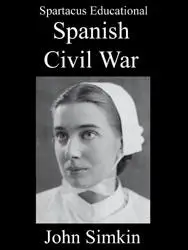Jose Maria Gil Robles

José Maria Gil Robles was born in Salamanca in 1898. After university he became a journalist with Catholic daily newspaper, El Debate. He was active in right-wing politics and was a member of Partido Social Popular.
Gil Robles was a supporter of the dictatorship of Miguel Primo de Rivera. After the establishment of the Second Republic in April 1931 he joined Accion Nacional and was elected to the Cortes for Salamanca.
On 28th February, 1933, Gil Robles helped to establish the Confederatión Espanola de Derechas Autónomas (CEDA), out of a collection of small right-wing parties opposed to the policies of Manuel Azaña and his Republican government.
In the 1933 elections, the CEDA won the majority of seats in the Cortes. President Niceto Alcalá Zamora refused to ask Gil Robles to form a government. However, seven members of the CEDA served as ministers during the next three years. This included Gil Robles, who held the post of Minister of War.
On 15th January 1936, Manuel Azaña helped to establish a coalition of parties on the political left to fight the national elections due to take place the following month. This included the Socialist Party (PSOE), Communist Party (PCE) and the Republican Union Party.
The Popular Front, as the coalition became known, advocated the restoration of Catalan autonomy, amnesty for political prisoners, agrarian reform, an end to political blacklists and the payment of damages for property owners who suffered during the revolt of 1934. The Anarchists refused to support the coalition and instead urged people not to vote.
Right-wing groups in Spain formed the National Front. This included the CEDA and the Carlists. The Falange Española did not officially join but most of its members supported the aims of the National Front.
The Spanish people voted on Sunday, 16th February, 1936. Out of a possible 13.5 million voters, over 9,870,000 participated in the 1936 General Election. 4,654,116 people (34.3) voted for the Popular Front, whereas the National Front obtained 4,503,505 (33.2) and the centre parties got 526,615 (5.4). The Popular Front, with 263 seats out of the 473 in the Cortes formed the new government.
The Popular Front government immediately upset the conservatives by realizing all left-wing political prisoners. The government also introduced agrarian reforms that penalized the landed aristocracy. Other measures included transferring right-wing military leaders such as Francisco Franco to posts outside Spain, outlawing the Falange Española and granting Catalonia political and administrative autonomy.
As a result of these measures the wealthy took vast sums of capital out of the country. This created an economic crisis and the value of the peseta declined which damaged trade and tourism. With prices rising workers demanded higher wages. This led to a series of strikes in Spain.
On the 10th May 1936 the conservative Niceto Alcala Zamora was ousted as president and replaced by the left-wing Manuel Azaña. Soon afterwards Spanish Army officers, including Emilio Mola, Francisco Franco and José Sanjurjo, began plotting to overthrow the Popular Front government. This resulted in the outbreak of the Spanish Civil War on 17th July, 1936.
Gil Robles supported the Nationalist Army during the war. He was unwilling to struggle with General Francisco Franco for power and in April 1937 announced the dissolution of the CEDA.
At the end of the Civil War he went into exile. He returned in the 1960s and became one of the leaders of the Spanish Christian Democracy. José Maria Gil Robles died in 1980.
Primary Sources
(1) Edward Knoblaugh, Correspondent in Spain (1937)
Azana's government had a difficult time maintaining order. There was a rash of strikes, violence, church burnings and other disorders. Virtually all the news coming out of Spain during my first nine months there dealt with these disorders. Each day would see some new form of violence-some phase of industry tied up or some blood spilled. Rex Smith, then bureau manager of the Associated Press in Madrid, once quite appropriately remarked that it might save us time and cable tolls if we had stereotyped forms made for New York and referred to them by number in indicating repetitions of violence.
The Azana government found itself obliged to use strong measures to curb the disorders. One of these incidents caused Azana's overthrow. Thirteen anarchists, having barricaded themselves in a cafe called Casa de Seis Dedos in the little village of Casas Viejas, fired on the police. The head of the Casas Viejas constabulary asked Madrid for instructions. The Ministry of Interior sent orders to the effect that the place should be cleaned up: "we want neither prisoners nor wounded." The police took these orders literally. Not one of the thirteen escaped alive
The extreme Left took up Casas Viejas as their war cry the thirteen men who had been killed by police bullets became martyrs. Public opinion was so aroused that, following Spanish tradition, it ended in reaction. The Right-Centre coalition of the then unknown newspaperman, Jose Maria Gil Robles, carried the November, 1933, elections in a sweeping upset. Azana was ousted. Gil Robles, by virtue of heading the largest parliamentary minority - the Popular Action group with 112 of the 473 Cortes votes - was first in line to succeed him. But President Niceto Alcala Zamora, although a strong Catholic, did not deem it wise to encourage a Right trend in parliament at that time. Instead, he named Lerroux, the veteran, to the post of Premier.
Gil Robles demanded and was granted a place in the new government of Alejandro Lerroux. Not only a place but the place he wanted - the Ministry of War. As war minister he ruled with an iron hand. Violence disappeared from Spain for the next year. The Left, stung by its defeat of October, abandoned force as a weapon and fell back on parliamentary obstruction. The repressive measures adopted by the government during the revolt was the peg upon which the Left Wingers hung their new program of attack.

